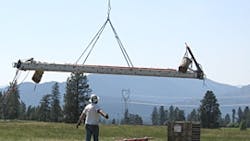BPA Line Crews Get Help from Above
From the ropes of helicopters BPA has dangled linemen, transported stretchers and moved aerial carts. Now, BPA Transmission is taking aircraft support a step further and incorporating it into the daily maintenance of Field Services.
Crew members from Kalispell, Mont., replaced aging insulators in Thompson Falls using the help of a helicopter. The aircraft transported scaffolds and materials to lineman perched on the transmission tower.
Areas with islands and steep terrain along rivers and canyons tend to offer unstable landings to set up heavy equipment, such as multi-ton cranes. Thompson Falls is a good example of complications that surround routine maintenance in many areas of the Pacific Northwest.
"Here, there are narrow roads and landings where we can't use a crane," says Mike Stolfus, foreman III with Kalispell Transmission Line Maintenance. "We have steep cliffs that are home to bighorn sheep and a number of towers on the islands in Clark Fork River."
For decades, linemen have relied on heavy equipment to transport people and materials throughout the region's now 300,000 sq mi of service area. But, moving certain equipment in challenging terrain can slow down projects. Also, the impact can take its toll on land in the path of the right of way.
"This work is going to start opening a lot of doors for alternate methods of maintenance," says District Manager Mike McCracken from Kalispell Operations and Maintenance. "It's allowing us to get into those hard-to-get spots where traditional methods would likely lead to excavation and ground disturbing activities."
"Using the helicopter means we don't run into as many environmental or cultural and additional expense issues caused by building larger or new landings at the tower sites," says Stolfus. "Now we can use existing landings without disrupting the soil."
While the Kalispell crew honed in on maintenance using aerial support, they found some positive results.
"We were able to develop procedures to efficiently change insulators with the helicopter that were as fast - and in some cases faster - than using traditional methods," says Stolfus. "We started with a few ideas with the rigging and tools and then adapted to what worked best with the helo."
"It was a typical team effort with input from all crew members," Stolfus adds. "This job was another fine example of teamwork between TLM, Aircraft Services, Heavy Mobile Equipment Mechanics and Technical Services."
The agency continues to find many uses for aerial support near transmission lines. Some have already proved their worth. Last year, helicopter-based rescue training for injured victims became mandatory after earlier exercises were put to use in a work-related emergency.
